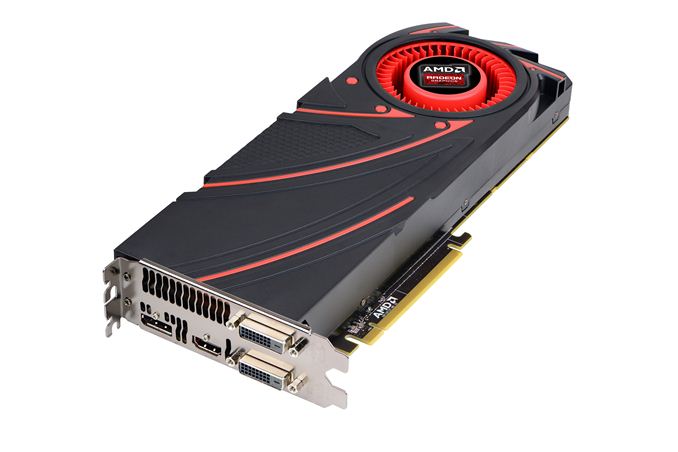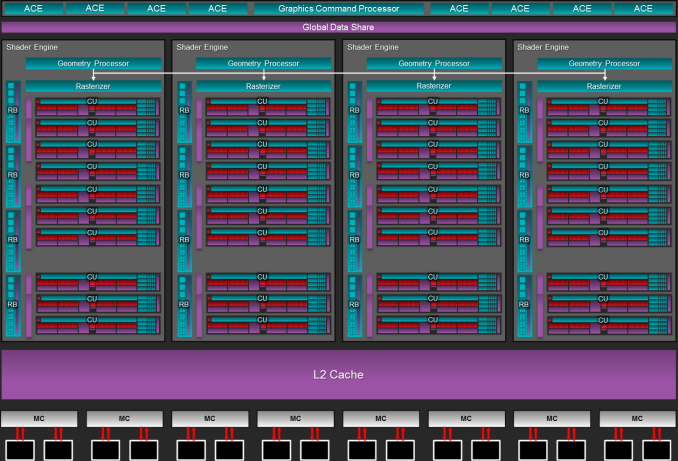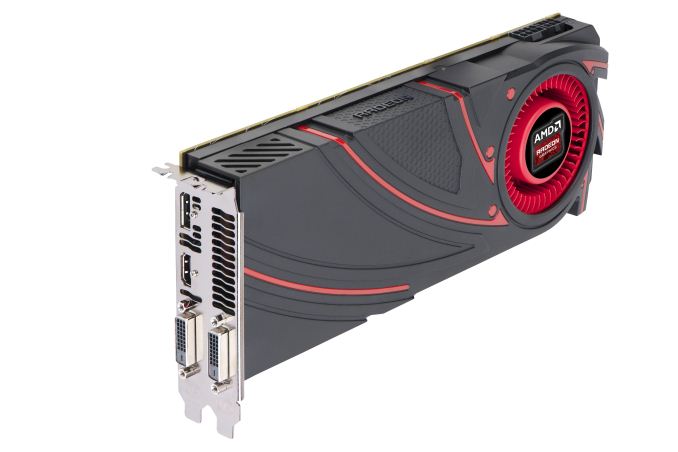The AMD Radeon R9 290 Review
by Ryan Smith on November 5, 2013 12:01 AM EST- Posted in
- GPUs
- AMD
- Radeon
- Hawaii
- Radeon 200

With the launch of AMD’s Radeon R9 290X less than 2 weeks ago, the video card marketplace has become very active very quickly. The 290X not only reasserted AMD’s right to fight for the video card performance crown, but in doing so it has triggered an avalanche of pricing and positioning changes that have affected both NVIDIA and AMD.
NVIDIA for their part cut the price of the GTX 780 and GTX 770 to $500 and $330 respectively, repositioning the cards and giving them their first official price cuts since their spring launches. Meanwhile AMD has also made some changes, and although 290X is unaffected for the moment, 290 was affected before it even launched, receiving an arguably significant specification adjustment. Consequently with GTX 780’s price cut being NVIDIA’s counter to 290X, 290 has gone from just being a lower tier Hawaii card to also being AMD’s counter-counter, and in the process has become a somewhat different card than what it was going to be just one week ago.
But before we get ahead of ourselves, let’s start at the beginning. With the successful launch of the 290X behind them, and the equally successful launch of their new flagship GPU Hawaii, AMD is ready to make their next move. Launching today will be the Radeon R9 290, the obligatory lower-tier part for AMD’s new flagship lineup. Making the usual tradeoffs for a lower-tier part, AMD is cutting down on both the number of functional units and the clockspeeds, the typical methods for die harvesting, in exchange for a lower price. Now officially AMD has not announced the Radeon R9 290 in advance, but with listings for it having already gone up on the same day as the 290X, it’s something that everyone has been expecting.
As always we’ll offer a full breakdown of performance and other attributes in the following pages, but before we even begin with that we want to point out that the 290 is going to be one of AMD’s most controversial and/or hotly debated launches in at least a couple of years. The merits of 290X were already hotly debated in some gaming circles for its noise relative to its performance and competition, and unfortunately 290 is going to be significantly worse in that respect. We’ll have a full rundown in the following pages, but in a nutshell AMD has thrown caution into the wind in the name of maximizing performance.
| AMD GPU Specification Comparison | ||||||
| AMD Radeon R9 290X | AMD Radeon R9 290 | AMD Radeon R9 280X | AMD Radeon HD 7970 | |||
| Stream Processors | 2816 | 2560 | 2048 | 2048 | ||
| Texture Units | 176 | 160 | 128 | 128 | ||
| ROPs | 64 | 64 | 32 | 32 | ||
| Core Clock | 727MHz | 662MHz | 850MHz | 925MHz | ||
| Boost Clock | 1000MHz | 947MHz | 1000MHz | N/A | ||
| Memory Clock | 5GHz GDDR5 | 5GHz GDDR5 | 6GHz GDDR5 | 5.5GHz GDDR5 | ||
| Memory Bus Width | 512-bit | 512-bit | 384-bit | 384-bit | ||
| VRAM | 4GB | 4GB | 3GB | 3GB | ||
| FP64 | 1/8 | 1/8 | 1/4 | 1/4 | ||
| TrueAudio | Y | Y | N | N | ||
| Transistor Count | 6.2B | 6.2B | 4.31B | 4.31B | ||
| Typical Board Power | ~300W (Unofficial) | ~300W (Unofficial) | 250W | 250W | ||
| Manufacturing Process | TSMC 28nm | TSMC 28nm | TSMC 28nm | TSMC 28nm | ||
| Architecture | GCN 1.1 | GCN 1.1 | GCN 1.0 | GCN 1.0 | ||
| GPU | Hawaii | Hawaii | Tahiti | Tahiti | ||
| Launch Date | 10/24/13 | 11/05/13 | 10/11/13 | 12/28/11 | ||
| Launch Price | $549 | $399 | $299 | $549 | ||
Diving right into the hardware specifications, Radeon R9 290 is a bit more powerful than usual for a lower-tier part. AMD has cut the number of CUs from 44 to 40 – disabling 1 CU per SE – while adjusting down the base GPU clockspeed and boost GPU clockspeed to from 727MHz and 1000MHz to 662MHz and 947MHz respectively. However AMD has not cut the amount of memory, the memory clockspeed, the memory bus width, or the number of ROPs, leaving those at 5GHz for the memory clockspeed, 512-bits for the memory bus width, and all 64 ROPs for the back-end hardware.
As a result the differences between the 290 and 290X are on paper limited entirely to the clockspeed differences and the reduced number of CUs. At their top boost bins this gives 290 95% the clockspeed of 290X, and 91% of the shader hardware, giving 290 100% of 290X’s memory performance, 95% of 290X’s ROP and geometry performance, and 86% of 290X’s shading/texturing performance.
Compared to AMD’s last generation offerings, the 290 is going to be closer to 290X than 7950 was to 7970. 290 retains a larger percentage of 290X’s shader and ROP performance, never mind the fact that the full 320GB/sec of memory bandwidth is being retained. As such despite the wider price difference this time around, performance on paper is going to be notably closer. Paper will of course be the key word here, as in the case of 290 more so than any other card we’ve looked at in recent history theory and practice will not line up. Compared to the 290X, practice will be favoring the 290 by far.
Moving on to power consumption, perhaps because of AMD’s more aggressive specifications for their lower-tier card this time around, power consumption is not dropping at all. AMD is still not throwing us any useful hard numbers, but based on our performance data we estimate the 290 to have a nearly identical TDP to the 290X, leading us to keep it at an unofficial 300W. Lower-tier parts typically trade performance for power consumption, but that will not be the case here. Power consumption will be identical while performance will be down, so efficiency will be slipping and 290 will have all the same power/cooling requirements as 290X.
Meanwhile like the 290X launch, the 290 launch is going to be a hard launch, and a full reference launch at that. As such we’ll be seeing 290 cards go up for sale at the usual retailers today, with all of those cards using AMD’s reference cooler and reference board, itself unchanged from the 290X.
As for pricing and competitive positioning, AMD will be launching the 290 at what we consider to be a very aggressive price of $399. Based on the initial specifications, the performance, and the competition, we had been expecting AMD to launch this at $449, mirroring the launch of the 7950 in the process. But AMD has gone one step further by significantly undercutting both themselves and NVIDIA.
290’s immediate competition on the AMD side will be the $549 290X above it and the $299 280X below it, while on the NVIDIA side the competition will be the $499 GTX 780 above it and the $329 GTX 770 below it. Pricing wise this puts 290 as closer competition to 280X/GTX 770 than it does the high-tier cards, but as we’ll see in our benchmarks AMD is aiming for the top with regards to performance, which will make price/performance comparisons both interesting and frustrating at the same time.
NVIDIA for their part will have their 3 game Holiday GeForce Bundle on the GTX 780 and GTX 770, presenting the same wildcard factor for overall value that we saw with the 290X launch. As always, the value of bundles are ultimately up to the buyer, especially in this case since we’re looking at a rather significant $100 price gap between the 290 and the GTX 780.
| Fall 2013 GPU Pricing Comparison | |||||
| AMD | Price | NVIDIA | |||
| Radeon R9 290X | $550 | ||||
| $500 | GeForce GTX 780 | ||||
| Radeon R9 290 | $400 | ||||
| $330 | GeForce GTX 770 | ||||
| Radeon R9 280X | $300 | ||||
| $250 | GeForce GTX 760 | ||||
| Radeon R9 270X | $200 | ||||
| $180 | GeForce GTX 660 | ||||
| $150 | GeForce GTX 650 Ti Boost | ||||
| Radeon R7 260X | $140 | ||||












295 Comments
View All Comments
DMCalloway - Tuesday, November 5, 2013 - link
I agree. My major concern at this point isn't noise or that custom coolers will not be able to dissipate given thermals, but 95*C is a LOT of heat to dissipate into the case. Usually custom coolers are open. It's going to be like running a serious hair dryer in the case.looncraz - Tuesday, November 5, 2013 - link
The 95C figure doesn't matter, only the TDP. This card is by no means in new territory - just in new territory for a stock AMD card with this cooler. A better cooler will still run at 95c if that is the driver and fan speed target, so you will have to rely on the quieter, better, coolers AND custom fan profiles or CCC lower target temperatures. Set the target temperature too low for the cooler and the speed will throttle... so performance will be directly related to the quality of the cooling - which really makes me wonder why AMD didn't consider upgrading their cooler... just looking at their design I can see several ways to improve it for virtually no R&D and very little extra manufacturing cost... a card that has to throttle at stock is a card that needed a little more love before release.DMCalloway - Wednesday, November 6, 2013 - link
Yeah, I get that part. It's still a chip running at higher temps. while drawing at least 50 more watts of juice. Of course the chip will run fine at 95*C+ temps, my concern is with an open heat sink the amount of thermal energy being dissipated into the case is going to be higher. Better coolers more effectively cool the chip, irrelevant for case temps.jjj - Tuesday, November 5, 2013 - link
THG got some retail 290x and they perform a lot worse than the review sample so at this point it seems unclear what the actual perf is for 290 and 290x. You guys need to check if AMD cherry picked the review samples,sending cards that clock well and they sell far slower cards.HisDivineOrder - Tuesday, November 5, 2013 - link
I'd love it if they'd start testing these cards in some cases. Testing them on open air benches is the best way to ignore the obvious heat that's going to build up in a case that's got one, let alone two of these boards, using passive heat loss to help them.Boards this hot running continuously need to be in a case to test for how long it can maintain its boost.
Ryan Smith - Tuesday, November 5, 2013 - link
We do test in a case. All of our tests take place in a NZXT Phantom 630 WE.techkitsune - Tuesday, November 5, 2013 - link
"All of our tests take place in a NZXT Phantom 630 WE."That's about as acoustically horrible as the old black and purple SGI Irix cases. No wonder you registered such a high noise level.
Nikhilanand - Tuesday, November 5, 2013 - link
R9 290 is a performance beast for its price. Almost nearing its big brother R9 290x. Nvidia's latest price cut won't help GTX 780's further sales now. But AMD's partners need to make this one cooler and quieter.woolfe9998 - Tuesday, November 5, 2013 - link
I never comment on reviews, but I was taken aback by the reviewer's final comments. Presuming on behalf of every enthusiast that the noise generated by this card makes it unacceptable even with such a strong price/performance ratio is odd. Everyone has a different noise tolerance. Judging from the comments, most of us are excited about this card, in spite of the reviewer's final remarks which seem to suggest the card's status as a bad product as objective fact when actually the issue of noise tolerance is subjective. The reviewer doesn't seem to understand that even if the noise level actually IS unacceptable, we're not stuck with the reference cooler for very long. Better coolers will come quickly. What a strange review.techkitsune - Tuesday, November 5, 2013 - link
Some of us won't wait for the aftermarket cooler if we want it quiet. We'll rig a water block to it and hook it into the loop. :) Then it will be absolutely silent, the only noise coming from the radiator fans. Three 9,000 RPM Delta fans. ;)